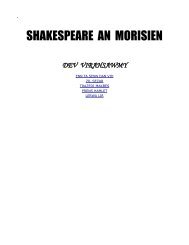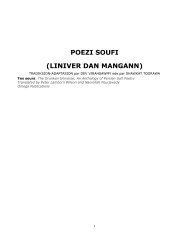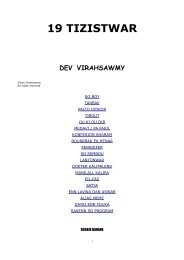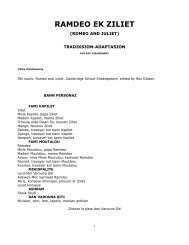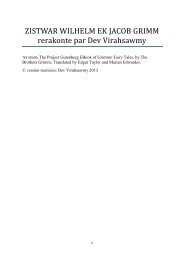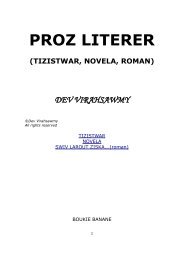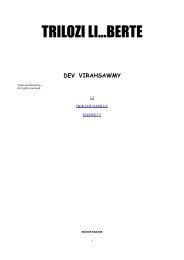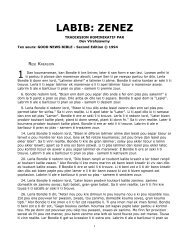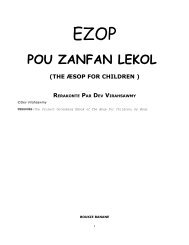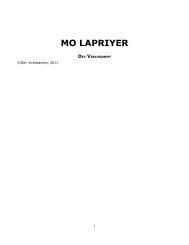LITERESI BILENG AVANSE - boukie banane
LITERESI BILENG AVANSE - boukie banane
LITERESI BILENG AVANSE - boukie banane
Create successful ePaper yourself
Turn your PDF publications into a flip-book with our unique Google optimized e-Paper software.
typical Creole island, as defined above. Today it is known as a multiracial, multicultural and multilingual<br />
country.<br />
Mauritius is also known as the Star and Key of the Indian Ocean because before the opening of the Suez Canal<br />
in 1869, ships from Europe had to round the Cape of Good Hope on their way to India and upon entering the<br />
Indian Ocean needed a port of call for fresh water, food and repairs. The island could offer that.<br />
The strategic location of Ile de France in the Indian Ocean was a real asset to the French. History has it that<br />
during the Napoleonic wars Ile de France was used as a base from where French corsairs mounted successful<br />
raids on British commercial ships sailing between Europe and the East. According to historians, “The<br />
Napoleonic period was a period of bitter rivalry between French and English forces to control the Indian<br />
Peninsula. Ile de France had a strategic position because of its good labour. It was the port of call of the French<br />
naval forces fighting the British in the Indian Ocean. ... Moreover almost everything could be obtained from Ile<br />
de France. Merchant ships therefore stopped going to India, which proved detrimental to trade in India.” The<br />
island had become a trading post.<br />
The British took over the island in 1810. The strategic and commercial importance of Mauritius declined<br />
dramatically in 1869 when the Suez Canal, "The Highway to India", was opened. Mauritius remained a British<br />
colony until independence in 1968. Is it still the star and key?<br />
After a short period of hard times due to high birth rate and dependence on one cash crop (sugar), the<br />
economy was diversified and some prosperity was experienced through tourism and manufacturing. Further<br />
innovations and the development of new fields of activities such as the seafood hub, financial services, freeport<br />
and offshore activities, and ICT have helped Mauritius to move from a low income economy to a middleincome<br />
one. Its ambition now is to move further up and it will succeed because it is still the star and key. A<br />
suitable time zone has enabled the development of new ICT businesses. While western capitalism is facing<br />
serious difficulties, BRICS countries (Brazil, Russia, India, China and South Africa) are offering Mauritius new<br />
development possibilities. Three of these countries are 'neighbours'. They are South Africa, India and China<br />
with whom we have more than just business ties. As a consequence, that little dot on the Indian Ocean map<br />
has become the hyphen which connects Africa and Asia making of Mauritius the Africa-Asia connection. And<br />
that is good for those interested in doing business with both Africa and Asia.<br />
But geography is only one side of the picture. We need to understand the place of nurture as opposed to<br />
nature to get the full picture. A mixed economy blended with social-democratic policies, the firm belief that<br />
market forces should not be allowed to dictate everything, an unswerving faith in a welfare state have also<br />
helped to chart a course where prosperity and general happiness are not at loggerheads. When Kovils, Shivalas,<br />
Mosques, Churches, Pagodas and Temples stand side by side in mutual respect some kind of tolerance is<br />
generated because the foundation of cultural dialogue has been laid. Most interesting in the culture field is the<br />
language situation. A dozen languages from different lands have survived and a new one has developed and<br />
now has its roots deep into the heart of the republic. It is our National Language, Mauritian, also known as<br />
Mauritian Creole. For those who don't know it, a creole language is one which is born out of the contact, clash<br />
and collision of two or more languages. In its initial stage it is called a pidgin, a very simple mode of<br />
communication. With time it grows into a creole when it becomes the mother tongue of a new generation. This<br />
10



